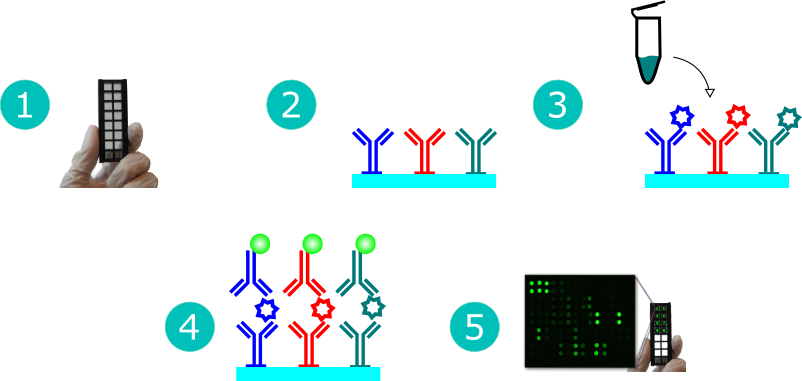Your ELISA kit is missing something! If you're still using ELISA for biomarker analysis, you're missing out on vital insight. You're also leaving time, money, and sample on the table. Learn about antibody arrays, a better solution for complete biomarker analysis.
Running an antibody array is like running dozens of ELISAs simultaneously. Arrays allow you to collect comprehensive, quantitative data on up to 40 different of related biomarkers at the same time, all while saving time, money, and precious sample volume. Learn about how antibody arrays work, and read more about the benefits of antibody arrays below.
How Does an Antibody Array Work?
Antibody arrays are fairly simple devices that operate on principles most researchers are already familiar with. The simplest way to explain an antibody array is to compare it to a common and familiar method, the ELISA.
Quantibody array panels are stunningly simple to use, read, and analyze.
Each panel can quantify up to 40 different biomarkers simultaneously, and individual panels can be multiplexed to quantify as many as 660 different biomarkers at one time. The entire process can be completed in just 4-6 hours.
Antibody Array Workflow

- Each Quantibody array starts with a single glass microscope slide, which acts as a support for the array. Slides are segmented using a rubber gasket. Up to 8 samples may assayed using a single slide.
- Antibodies against a variety of different antigens (up to 40 biomarkers per slide) are printed onto the glass slide. Replicates are included, saving you both time and precious sample volume.
- The end-user adds either known concentration standards (included) or aqueous sample to each well on the slide. Antibodies on the slide capture antigen off from the sample or standard.
- Fluorescent signal from each spot is read using a laser slide scanner. The intensity from each spot is compared to the standard curve, and a quantitative expression profile for relevant biomarkers is established.
- Each Quantibody array starts with a single glass microscope slide, which acts as a support for the array. Slides are segmented using a rubber gasket. Up to 8 samples may assayed using a single slide.
Difference between Antibody Array and ELISA
Like an ELISA, antibodies capture antigen out of an aqueous sample matrix (blood plasma, serum, and cell-culture media) are all common sample matrices analyzed via arrayand ELISA. The main difference between an array and an ELISA is the diversity of antibodies on the support matrix, and by extension the number of biomarkers that can be analyzed simultaneously. ELISAs have the same capture antibody coated in each well and are capable of detecting only one biomarker at a time. By contrast, an antibody array contains many different capture antibodies arranged in distinct spots. Antibody arrays are capable of capturing, distinguishing between, and detecting dozens of biomarkers simultaneously!
Do you need quantitative data on an exceptionally broad range of targets? Multiplexed array sets like Human Cytokine Array Q440 combine multiple non-overlapping array slides, for analysis of up to 440 biomarkers at once.
During the detection phase of the assay, both arrays and ELISAs produce a quantifiable signal that corresponds to the amount of the respective biomarker in samples that have been assayed. ELISAs typically rely on a chromogenic substrate that changes color, and signal is detected and calculated by analysis on a spectrophotometric plate reader.
Antibody arrays may use either chemiluminescent signal (for nitrocellulose membrane based arrays), or fluorescent signal (for glass-slide based arrays). Data is collected using either a standard Gel-doc system, or a slide scanner respectively.
Following detection and data collection, the signal generated is compared to a set of known-concentation standards and quantitative or semi-quantitative results are computed for on each biomarker analyzed.
Why Is an Array Better than an ELISA?
While the antibody array can, in many ways, be compared to the ELISA, it is an undeniably superior platform for proteomic analysis. Unlike an ELISA, an array is able to provide quantitative data on up to several undred of different biomarkers simultaneously, but the benefits don't stop there!
Read more about how an array can help you improve your laboratory workflow below:

Save Time
In just 4-6 hours (the same amount of time required to complete just one ELISA) you can generate quantitative data on 200+ related biomarkers.
Example: The Human Inflammation Array Q3 (ABIN625744) can quantify 40 different Human inflammatory markers simultaneously, in just 4-6 hours. To quantify the same number of targets using ELISA kits you would have to invest 80 hours. That's almost 2 whole weeks worth of work! Calculations based on 40 different ELISAs, 4 hours per ELISA run, 2 runs possible simultaneously, 40 hours per work-week.

Preserve Sample
Your samples are precious, expensive, and difficult to acquire! Make the most of them. Comprehensive biomarker analysis uses as little as 0.25µL of sample per analyte.
Example: The Human Growth Factor Array Q1 (ABIN625732) can quantify 40 different Human growth factors simultaneously on a single slide, using just 100µL of sample (0.25µL per growth factor). Quantifying targets using ELISA kits you would consume at least 4mL of sample! Calculations based on 40 different kits, all samples assayed in duplicate, 50µL per sample instance.

Save Money
Arrays are surprisingly cost effective (less per target than most ELISAs), and the savings scale up! The more biomarkers you analyze, the more you save!
Example: The Human Chemokine Array Q1 (ABIN625717) can quantify 40 different Human chemokines simultaneously. The kit price for up to 50 different samples is just $4,416.72. To quantify the same number of targets using ELISA kits you would have to spend an average of $40,000.00! Calculations based on 40 different targets, 2 kits per target, $500.00 average cost per kit.

Get Better Data
One molecule never tells the whole story. Use an arrray to generate beautiful, complete, quantitative data about your target-of-interest, and the pathways that surround it.
Example: The Human Cytokine Array Q440 (ABIN4956030) can quantify 440 different Human cytokines simultaneously. You can use this data to gather a comprehensive picture, forming a deeper understanding of cytokine changes in response to a certain stimulus, and developing insight that you may have missed if analyzing only a handful of different targets.
Antibody Arrays Available for Purchase at Antibodies-Online:
Interested in a custom array? Want to learn more about antibody array technology?Contact our scientific support specialists: support@antibodies-online.com

Offered pre- and post-sales consultation and support to antibodies-online customers. Provided troubleshooting and technical assistance with proteomics and genomics experiments. Composed and distributed cross-channel digital marketing campaigns.
Go to author page



